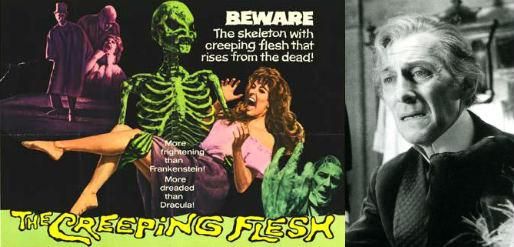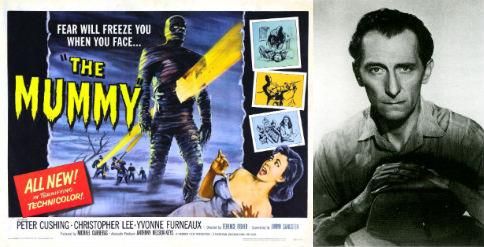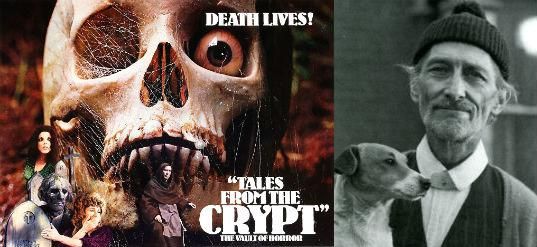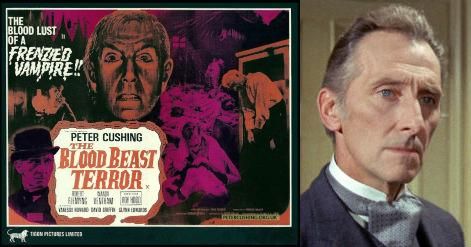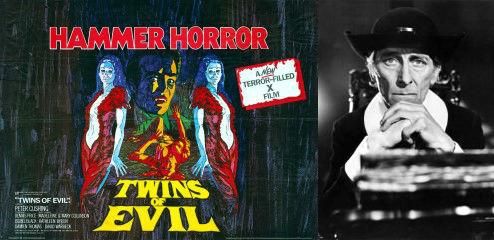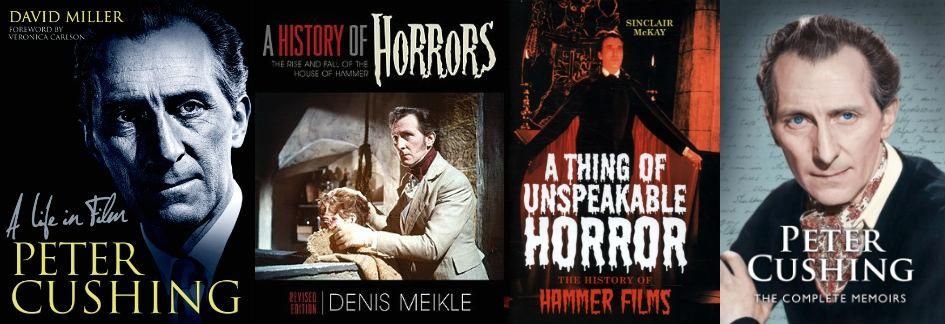“Seems I've spent the better part of my life amongst the dead.” PEOPLE! Sometimes They Are Uxorious! (Peter Cushing!)
/Sunday 26th May 2013 marks a very special occasion. Yes, 100 years ago on that day Peter Wilton Cushing OBE (26 May 1913 - 11 August 1994) was born.Look, he’s even on a bloody stamp! Happy Centenary, Peter Cushing!
 The Beast Must Die (Amicus,1974)
The Beast Must Die (Amicus,1974)
Anyway, this… Peter Cushing is/was/will always be EXCELLENT! And here's how we get to there from here...
Peter Cushing made 90 or so movies (and The Bitch ain't one). That's a lot of movies and sometimes the only reason to watch them is Peter Cushing. Even in the worst of his movies Cushing remains the steely calm at the eye of a storm of camp; the one man taking it all seriously enough to pin your attention to the screen; enhancing rather than undermining what is, in all probability, a load of seedily eerie nonsense. That doesn't mean he couldn't erupt into a frenetic flurry of startling physicality when required, because he could. Even better, not only was he a fine screen actor but he was agreed by all to be a genuinely decent and gentle man. So profound is the consensus on this that you could be forgiven for being permanently tensed to receive some terrible reputation soiling revelation. As of this writing no news has reached me that Cushing’s home was built from the bones of missing hitchhikers or that he liked to set fire to tramps and laugh, so we’ll adhere to the accepted text of his life.
Peter Cushing was raised in a comfortably middle class Surrey home where he appears to have wanted for little. His childish exuberance in play seems to have held fast throughout his life and found the perfect home in the adult equivalent of make believe; acting. He did, however, want for support in his desire to act. His father wasn't keen and, sadly, Cushing remained estranged from his elder brother, David, due to Cushing’s career choice until David’s death. When Cushing was 40 his father declared him a failure which was both appalling parenting and a trifle premature as at the age of 44 this failure would headline two of the most successful films in British cinema history;The Curse of Frankenstein (1958) and The Horror of Dracula(1959). (Anyone rolling their cynical eyes at my assertion earlier that Cushing could act, and act well, could do worse than to watch these performances back to back. Sure it's the same man but they are very, very clearly different characters.) 44 is hardly the bloom of youth and so it looks like success came late to Peter Cushing, but he had been quite successful for a while. In 1940 he had even been in the Americas and also in Laurel & Hardy's A Chump at Oxford (1940) amongst other well received movies. Following his return to Blighty (due to a small thing called WW2; he did not serve, he was not fit) he trod the boards and the sound-stages with Laurence Olivier (Hamlet, 1948), starred opposite a bewigged Richard Burton in Alexander The Great (1958) and appeared in the 1954 BBC adaptation of George Orwell's 1984 ; now widely regarded as Television's first masterpiece. Indeed, the small screen was where Cushing found his biggest success as his cinematic career stubbornly failed to gain traction. Such a common and popular sight was Cushing in the domestically screened plays of the day that to deny he was successful prior to Hammer would be to have a very narrow definition of success. But there's a kind of success that doesn't put money in the meter and that was the kind Cushing had. Well, until Hammer hit the anvil of success big style with The Curse of Frankenstein.
After that it was all gravy (vein gravy!!! Sorry.) but it had been a tough road. Luckily Cushing hadn't had to walk it alone. In 1942 Cushing had found emotional support in the form of Helen Beck whom he married on April 10th 1943. The tenacity and sincerity of Cushing’s love for Helen was such that swans look like slackers in comparison. Together they helped each other through periods of depression and physical illness, eventually enjoying the silliness of cinematic success as they deserved. In 1971 Helen Cushing died. After her death Peter Cushing was different. Oh, he was still Peter Cushing. He was still lovely. Still polite and gracious to all on set. Still able to keep visitors in stitches all afternoon. But he couldn't stand to have anyone interrupt his sight-line when filming now. And now he would be sighted less when not required on set. And, at least once, he would request his wife’s portrait be used when such props were required for his character to react to. And for a while the tears he wept on screen were real. He never got over it but he didn't forget he still had a life to live. So he got on with it. Peter Cushing was a charming English eccentric who always treated every film as though it mattered; he embodied strange notions such as courtesy and civility but was nobody's fool. He died in 1994.
I like to think I first encountered Peter Cushing’s filmed presence when lax parenting ensured I was, while still a child, allowed to stay up and watch horror movies on Friday nights. But then I like to think all sorts of things. No, it’s far more likely that Cushing’s relaxed command of the screen imprinted on me earlier via his several forays into child oriented fantasy movies. I would certainly have thrilled to his performance as The Doctor in Dr. Who And The Daleks (1965) and Daleks' Invasion Earth: 2150 A.D. (1966) Why, I can only imagine the good natured esteem they are held in by today’s easy going Who fans (AKA “Whosers”). You may be a bit thrown by the dates on those movies after all according to my passport I’m not quite that old. But back then, when we killed our own food, the only other outlet for visual entertainments was the time limited and channel light medium of Television. So, to maximise receipts movies remained in circulation a lot longer; even boomeranging back to more bums on seats some years after their initial release, as in the case of these entertainments. Sometimes, though, I’d catch a movie fresh as tomorrow.
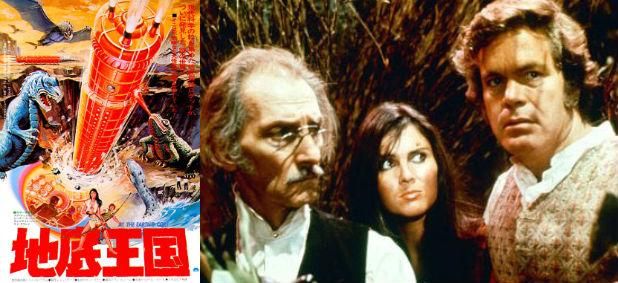 Peter “This Nation’s Saving Grace” Cushing, Caroline Munro (who could make masonry blush) and Doug “You May Know Me From…” McClure in the Amicus motion picture presentation At The Earth’s Core (1976)
Peter “This Nation’s Saving Grace” Cushing, Caroline Munro (who could make masonry blush) and Doug “You May Know Me From…” McClure in the Amicus motion picture presentation At The Earth’s Core (1976)
In fact one of the greatest cinematic experiences of my young life was going to “The Picture House” to see At The Earth’s Core (1976). Yes, it was a sheltered life, cheers. In this one Cushing played a primly bumbling professor who reached the earth’s core in a Very Big Drill accompanied by Doug McClure, a man who resembled an affably sybaritic cousin of George Peppard. There they found not only a subterranean race ruled by men in wholly unconvincing monster suits but also a sweaty Caroline Munro; yes, I have heard the sound of a hundred Dads crossing their legs simultaneously.
I would also have seen Cushing sporting a tinselly wig on TV in Gerry Anderson’s weekly live action exercise in failing to predict the future Space: 1999 circa 1976. From 1969 onwards Cushing had been making sporadic appearances on The Morecambe & Wise show, all of which were part of a long running joke about his seeking payment for his first appearance. This joke ended in 1980, I told you it was long running. And believe you me back then everybody watched Morecambe and Wise, or they got shipped off to Australia. Yes, there is a point beyond the ubiquity of Peter Cushing in The Dream Life of Albion, although I am moving steadily away from it. See, 1976 ,the year of At The Earth's Core's release, would also see the release of another fantastical entertainment for children featuring Peter Cushing. Yes, Peter Cushing witnessed the passing of the baton of escapist children's entertainment from Edgar Rice Burroughs to George Lucas.
"Far too many men are hobby-less...Without the escapism which comes only from dabbling with adult toys, their minds are prey to all the frustrations and fears of the working day. So many, it seems to me, lose happiness as they grow up. Their entire absorption in their careers and adult responsibilities bring lines of worry and premature old age. It is not silly or childish to have an interest in hobbies..." Peter Cushing in TV Mirror, July 1956 (taken from Peter Cushing; A Life in Film by David Miller, p.74)
He’s talking up the case for hobbies there; toy soldiers in particular. But he could have been talking about comics. He was known to have liked those too. Other than that bit where his mother dressed him like a girl, Peter Cushing was a healthy young British lad, and like all such stout hearted chaps had a healthy interest in comics. Little Peter Cushing is documented as favouring the periodicals Gem and Magnet. I looked them up and they seem a bit fusty and musty in comparison to the comics of even my far gone youth never mind today’s stuff. Cushing’s favourite was the Greyfriars feature written by Charles Hamilton (AKA Frank Richards). Greyfriars was, as you all know, the school in which the famous character Billy Bunter was boarded up. These strips no doubt involved high spirited tuck shop centred larks enabling readers to delight in the gentle rebellion of the characters and their thrillingly close shaves with having their backsides beaten with a stick. Yes, comics were somewhat more sedate and establishment friendly back then. Basically, these are the kinds of comics Pat Mills has spent his life ensuring never happen again. Given the demands on his finite time by his other hobbies of painting, model soldiers, model building together with his full time jobs of actor, loving husband and being the most decent man in the world, Cushing seem to have let the comics slip away. He did, however, have sufficiently fond memories to later reminisce in print and on Television about these early paper pals. Bless his cotton socks. Had he kept up the habit he would have no doubt have been thrilled to bits to find himself on the comics pages himself. Although it was hardly the Magnet his image graced.
Today Dez Skinn is chiefly renowned for his role in the whole Miracleman fiasco currently keeping Padraig O’Mealoid out of mischief, but before inadvertently embroiling some of comics finest talents (and Todd McFarlane) in Comics own Bleak House saga Mr. Skinn livened up 1976-84 by publishing House of Hammer/Halls of Horror. This was a B&W magazine focusing primarily on Hammer but also, and increasingly as Hammer slipped from relevance, on the wider area of the Horror genre. Now, given its title and somewhat lurid cover imagery even my comics illiterate parents could tell it wasn’t exactly Buster or Whizzer and Chips so I had to bide my tiny time. Luckily, and this really was terribly fortunate, there was a newsagents in the market who had a near full run HoH that, judging by the static size of the pile until I got stuck in, no one was interested in except little old Cresta drinker me. When I finally read HoH I liked it just fine, but what I liked most were the comic strips. A lot of these (naturally) were Hammer films which was nice; what was nicer was the level of talent was pretty impressive. Brian Lewis always stood out with his highly European layouts although I don’t know what happened to him, but I know what happened to Brian Bolland (Vampire Circus (1972)) and John Bolton (the further adventures of Father Shandor from Dracula: Prince of Darkness (1966)).
Neither of those movies have Peter Cushing in by the way, but HoH did adapt The Gorgon (1964), Horror of Dracula and Twins of Evil (1971) etc etc so obviously there are plenty of pages of comics in these magazines graced by the cadaverous visage of Peter Cushing. I can’t provide any scans or, indeed, any particularly original information as, sadly ,I have no physical evidence of my having purchased this magazine due to a hilarious misunderstanding where my parents thought that because I had grown older I had grown up; burning all my comics in my absence. Memories! It doesn't matter though because Dez Skinn his very self has a whole load of images and words about this very magazine at HERE. If that doesn't keep you busy I don’t know what will. Oh yeah, and that 1977 children's entertainment? That film. ..sigh, okay Star Wars, STAR WARS okay? Star Wars was adapted into the comics form for Marvel Comics and was drawn, at George Lucas' suggestion, by one Howard Victor Chaykin. I am still cruising on the fumes of the happiness my seven year old mind distilled on opening a Star Wars comic and finding Peter Cushing drawn by Howard Victor Chaykin. And in a risky narrative manouver there's where I'll choose to leave it - with a small child experiencing a magical confluence of all he thought was wonderful in the world; a lot of which he still finds wonder in. I've never really been one for goodbyes; best to go out on a high note. How smashing! How Cushing!
Thanks, Peter Cushing!
Happy Centenary!
Bibliography
No man, no matter how awesome he be, is born replete with Peter Cushing lore. Consequently, I am indebted to the books below for allowing me to beef up the preceding with something other than whimsical nostalgia. There's some of that, yes, but that's not the fault of these books. And nor are any (inevitable) errors; they’re all mine.
Peter Cushing: A Life In Film By David Miller, Titan Books, h/b £18.99 (2013) This is the one-stop 24 hour all night garage for all your Peter Cushing information needs. Need to know how many guineas Cushing was paid for a role? What kind of fry ups the builders who worked on his house made? ("Wonderful!", seriously). A mammoth effort of research rendered down into a breezyily paced and detail studded chronological chronicle of the man known as Peter Cushing. EXCELLENT! Unless you have no interest in Peter Cushing in which case I’m not really sure why you have read this far. Or if your taste can be trusted.
A History of Horrors: The Rise and Fall of Hammer By Denis Meikle Scarecrow Press, h/b £44.95 (2009) This one is thoroughgoing history of Hammer Studios and so covers all their films with Peter Cushing in as well as the many which lacked his presence. I found this particularly informative about the less familiar, to me, pre-success Hammer period and the studio’s final flailing at various, perhaps thankfully, unrealised projects (Nessie! Vampirella!). Although the price and paper suggest it is some tedious reference affair Meikle makes his subject interesting and even slips in some very good jokes now and again. Comes with an introduction by Peter Cushing in which he says nice things about, well, everybody, dear hearts. Simply everybody! Simply VERY GOOD!
A Thing of Unspeakable Horror: the History of Hammer Films By Sinclar McKay Aurum Press Ltd, h/b £16.99 (2007) This is another history of Hammer but written with the emphasis firmly on the entertaining. McKay’s frothy approach does mean that it is still enjoyable even if you have already read a history of Hammer, but slack editing lets through a few errors even I could spot. (Yes, Hilary Mantel, I know I have no room to talk.) To McKay’s credit unlike other, cleverer, books he doesn't shy away from the nightmarish horror of the execrable On the Buses movie series. As a casual and light hearted introduction to Hammer it’s GOOD!
Peter Cushing: The Complete Memoirs by Peter Cushing Signum Books, h/b £19.99 (2013) A centennially stimulated repackaging of the two previous Cushing autobios (An Autobiography, Past Forgetting) with the 1955 memoir The Peter Cushing Story as a single volume. This didn't arrive in time for me to read it but I'm sticking it on the list because it is a primary source for all the other books. I have read the two autobios though, back when I had more hair on my head than up my nose, and recall them being charmingly wobbily canters through the life of the great man himself related in his own endearingly effusive style(!). His memoirs may be surprisingly light on Hammer but are startlingly frank regarding some of the more distressing events in his life. This new edition also has some quite lovely informal photos of Cushing rocking his perennial cravat and slacks look down the ages. It’s the man himself in his own words so it could never be less than EXCELLENT! However, the reader does have to supply their own slippers, biscuits and hot tea.
A Selective Peter Cushing Filmography
 Peter Cushing Suffering For His Art with Veronica Carlson.
On the set of Frankenstein Must Be Destroyed (1969)
Peter Cushing Suffering For His Art with Veronica Carlson.
On the set of Frankenstein Must Be Destroyed (1969)
The Baron Frankenstein Series The Curse of Frankenstein (1956) The Revenge of Frankenstein (1958) The Evil of Frankenstein (1963) Frankenstein Created Woman (1967) Frankenstein Must be Destroyed (1969) Frankenstein and the Monster from Hell (1972)
The Van Helsing Series Horror of Dracula (1957) The Brides of Dracula (1960) Dracula A.D. 1972 (1971) The Satanic Rites of Dracula (1972) Legend of the Seven Golden Vampires (1973)
Portmanteau/Anthology (Basically, Like EC Horror Comics) Films Dr. Terror’s House of Horrors (1964) Torture Garden (1967) The House that Dripped Blood (1970) Tales from the Crypt (1971) Asylum (1972) From Beyond the Grave (1973) The Uncanny (1976)
Miscellaneous The Hound of the Baskervilles (1958) The Mummy (Hammer, 1959) The Gorgon (1964) The Skull (1965) Blood Beast Terror (1967) The Vampire Lovers (1970) Twins of Evil (1971) Horror Express (1971) The Creeping Flesh (1972) Madhouse (1973) The Beast Must Die (1973) The Ghoul (1974) Legend of the Werewolf (1974) House of the Long Shadows (1982)
Children’s Entertainments Night Creatures (1962) She (1964) Dr. Who and the Daleks (1965) Daleks Invasion Earth 2150 A.D. (1966) At the Earth’s Core (1976) Star Wars (1976) Arabian Adventure (1978)


